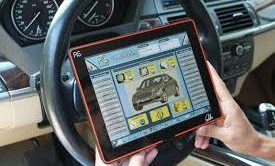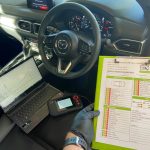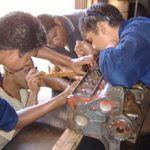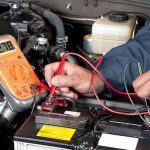Are you interested in a career that lets you do the work that really excites you? Do you want to turn your passion for Automobiles to a lifetime rewarding career? Do you want to enter a growing, rewarding career field? Are you ready to take the first steps in the right direction?
Starting your automotive career is more than just about loving cars. It’s about becoming a skilled professional, and knowing what to do and when to do it. Working on today’s cars requires an understanding in the science and technology that goes into the modern, highly-sophisticated automobile.
Now you can train to become an Auto Service Technician, Auto Mechanic, Auto Electrician an Auto Diagnostician and so on. You will learn all the skills required to inspect, diagnose and repair the new computerized vehicles. On graduation, you receive the Automotive Mechanic/Technician Certificate from the Automotive Training Center.
PROGRAM TITLE: Automotive Mechatronics
This Automobile Diagnosis and Repair Training program is designed to provide you with the skills and knowledge required to become qualified as an Automotive Service Technician. It comprises the Mechanical, Electrical and the Computer aspects of the trade.
In this program you will receive a combination of on the job training and related classroom training, designed to produce fully qualified persons of journey person status in the Automotive Service Technician occupation. Under qualified instructors, you will become fully familiar with the materials, tools, principles and skills required in the Automotive Service Technician occupation.
Here’s a brief description of the automotive technician training offered in our Automotive Training program:
Basic to Advance Engine Management Systems
This training introduces the students to principles of electricity, testing, batteries, starting and charging systems, engine theory, engine component inspection and R&R, under hood noise diagnosis, cooling and lubrication systems, environmental management and service information systems.
Drivability Diagnostics
This training introduces students to computerized diagnostics equipment, powertrain control systems, on board diagnostics, distributor and electronic ignition systems, fuel systems, electric and hybrid electric vehicles, exhaust emission systems, customer relation techniques and electronic accessories.
Drivetrain system
This training introduces students to torque converters, planetary gears, transmission hydraulics and clutches, manual transmissions and transaxles, four-wheel drive and all-wheel drive, differentials, precision measuring instruments, removal and replacement of transaxles, electronic transmission diagnostics, manual clutches and drivelines.
Chassis & Body Systems
This training introduces students to Body & Chassis on-board diagnostics, heating and air conditioning systems (HVAC), wheel bearings, brake systems, traction control systems, supplemental restraint systems (SRS), steering and suspension systems, immobilizer and security system, tires, wheel balancing, computerized four-wheel alignment, vibration analysis,
Who is this training for?
1) Experienced Auto technicians (Mechanic or Electrician) who have already complete their apprenticeship training but want to learn how to use the Computerized Auto-diagnostics tools & techniques to diagnose & repair the modern computerized vehicles.
2) None Auto technicians who want to learn how to use the Computerized Auto-diagnostics tools & techniques to diagnose the modern computerized vehicles but not interested in complex repairs.
MECH 102: Auto maintenance and care
MECH 104: Automotive engines rudiments
Section 1: Basic Engine Operation
-
Engine Types and Engine configurations
-
Engine placement and mounting
-
Special engine designs
-
The lower-end assembly and the upper-end assembly
-
Engine performance ratings
-
Factors that affect engines’ performance
Section 2: Automotive engine lubrication systems
-
Lubrication system components
-
Oil types and classifications
-
Engine lubrication system maintenance
Section 3: Automotive engine cooling systems
Engine cooling-system components & flow of coolant.
Inspecting and testing an engine cooling system.
Cooling-system maintenance
Section 4: Automotive engine overhauling
Engine disassembling
Engine parts, their functions, inspection and replacement (The lower-end assembly and the upper-end assembly)
Engine reassembling
Engine service and maintenance
MECH 112: Automotive electrical system 1
- Electrical conductors and insulators
- Vehicle electrical circuits.
- Voltage, Current and Resistance
- Basic units of measurement
Ohms law - Use of Electrical Testing Equipment
- Common Problems in Automotive Electrical Circuits.
- Some Specific Examples of Automotive Electrical Circuit Problems.
- Automotive wiring diagrams
- Vehicle power center
- Automobile storage batteries
- Principles of magnetism and DC electric motors
- Starting systems
- Charging system
- Troubleshoot Car Electrical Problem
- Automotive wiring
MECH 110: Automobile suspension and steering system
Section 1: Suspension systems
(a) Rigid Axle Suspension System
- Coil spring Rigid axle suspension system
- Leef spring Rigid axle suspension
(b) Independent Suspension System
- McPherson Strut suspension system
- Double Wishbone Independent suspension system
- Torsion Bar suspension system
- Trailing Link suspension system
- Air suspension system
(c) Anti-Roll or Stabilizer Bar
Section 2: Steering System
(a) Types of Steering System
Standard mechanical (reciprocating ball) steering system
- Rack and pinion steering system
- Variable-Assist Power Steering (hydro-electrical) system
- Electric Power steering system
- Steer-by-wire steering system
- b) Steering System Configurations And Applications
- Rear wheel steering system
- Front wheel steering system
- Four wheel steering(4WS) system
(c) Maintenance of Steering & Suspension Systems
(d) Wheels & Tires
- Wheel Hub, Bearings, and Steering Knuckle
- Tires
- Wheel balancing & Alignment
MECH 114: Introduction to Auto Computer Controls Systems
Section 1: Auto Computer Systems
-
Computer system basics
-
Input sensors and output actuators
-
Overall computer system
-
Troubleshooting computer systems.
Section 2: Scan tools, diagnostics trouble-codes and diagnosis
-
Types of trouble codes
-
How trouble codes are set
-
Reading trouble codes
-
How to Clear trouble codes
-
Scan tools, types & functions
MECH 206: Automobile driveline and transmission system
Section 1: Driveline
Power transmissions General Overview
Front-wheel drive layout
Rear-wheel drive layout
Four-wheel drive layout
All-wheel drive layout
4WD vs. AWD
All-wheel drive transfer case,
Transfer case differential action
Differentials/ Axles
Section 2: Manual transmissions and trans-axles
Basic manual transmission operation
Manual transmission linkages and selectors
-
Manual transmission configurations
-
Manual transmission vs manual trans-axle
-
Clutch system types, parts, their functions, inspection and replacement
Section 3: Automatic transmissions and trans-axle
-
Basic automatic transmission Operation
-
Automatic transmission Types
-
Automatic transmission configurations
-
Automatic transmission vs automatic trans-axle
-
Automatic transmission service and maintenance
-
Automatic transmission disassembling
-
Automatic transmission parts, their functions, inspection and replacement
-
Automatic transmission reassembling
MECH 108: Automobile braking system
-
Typical Automobile braking system types
-
Braking system configuration
-
Disk brake system
-
Drum brake system
-
Braking system servicing (Parts, their functions, inspection and replacement)
-
Braking system bleeding
-
Parking brakes
-
Anti-lock braking system
-
ABS system devices & ABS systems troubleshooting
MECH 116: Auto engine control and performance
Section 1: Power train Control Modules (PCM)
Section 2: Fuel Injection System
Introduction
(a) Electronic Fuel Injection (Gasoline)
-
Gasoline fuel Injection system components and functions
-
EFI Sensors Inputs
-
Computer (pcm) controlled output (fuel injector pulses)
-
Types Of Injection Systems
-
(b) Diesel fuel injection system
-
Diesel Electronic Control Systems
-
Diesel Direct Injection systems
Section 3: Air Induction System
-
Introduction
-
Intake system components
-
Types of Induction Systems;
-
Naturally Aspirated Induction Systems
-
Forced Induction Systems
Section 4: Exhaust System
-
Introduction
-
Exhaust system components and functions
-
MECH 116: Engine control and performance 2
-
Coil Pac and Waste Spark distributor-less ignition system.
-
Coil on Plug Distributor-less Ignition System
Troubleshooting the Ignition Systems
-
Engine Won’t Start due to weak sparks no spark
-
Engine Misfires
-
Ignition system components testing and diagnosis
-
Ignition System Maintenance
Section 2:
Testing the Sensors and Actuators in the Fuel System & Induction Systems
Section 3: Emission Control System
-
Emission
-
Sources of emission
-
Emission Control System
-
Exhaust Gas Recirculation (EGR)
-
Evaporation Emission Control System (EVAP)
-
Secondary Air Injection System (SAI)
-
Variable Valve Timing System
-
Selective Catalytic Reduction (SCR)
-
Diesel Exhaust Fluid (DEF)
-
Diesel Particulate Filter (DPF)
-
Diesel Oxidation Catalyst (DOC)
MECH 118: Heating, Ventilation & Air conditioner system
-
Introduction
-
Air conditioner system components and functions
-
High pressure side and Low-pressure side
-
Air Conditioning Service Equipment
-
Air conditioning system problem symptoms, troubleshooting and repair procedures
-
Climate control systems
-
MECH 218: Accessories and optional equipment
-
Immobilizer anti-theft and alarm system
-
SRS and Air bag system
-
Cellular phone
-
Collision avoidance and parking assistance system
-
Entertainment system
-
Garage door opener system
-
Memory storage system
-
Advanced Driver Assistance Systems (ADAS)
-
Resources
- Trainin Brochure 3.43 MB
- Trainin Brochure 2 2.86 MB




